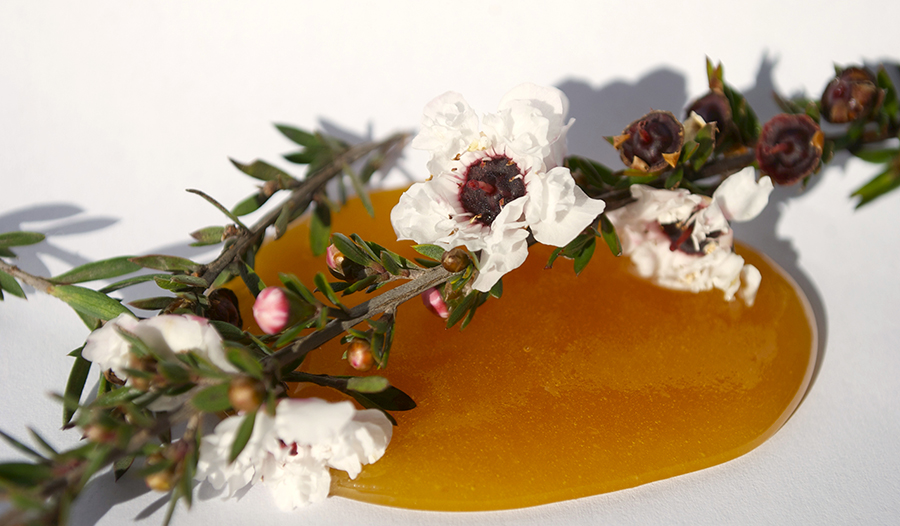6 Reasons Why Manuka Honey Is Unique

What is the buzz about Manuka honey and why is it so revered by health professionals, wellness practitioners, and elite athletes?
Hundreds of years ago, the Maori people of New Zealand used the Manuka tree for wellness remedies. One of the special things about the Manuka flower is its naturally antibacterial nectar found nowhere else in the world. Here are six explanations on why it’s so special.
1. It Contains Properties Not Found in Any Other Honey
All honey has some level of natural peroxide in them; however, Manuka honey is the only honey to contain both peroxide and non-peroxide antibacterial compounds (methylglyoxal, or MGO), the latter of which are more stable and aren’t destroyed upon eating.
MGO is the key compound attributed to the effectiveness of topical Manuka honey for healing wounds, burns, and cuts. Certified UMF™ Manuka honey with a UMF™10+ or higher rating is medical grade and therapeutic for the skin. It contains the beneficial compounds that provide Manuka’s unique topical antibacterial and health benefits, including support for wound healing, combatting staph infections (such as MRSA)1-6, and helping treat acne and scarring. To incorporate into your weekly beauty routine, use Manuka honey as a homemade face mask to keep your skin glowing.
2. It Supports Digestion and Immune Health
Manuka honey is widely used to support digestive (gut) health. Honey has a long history in traditional Chinese medicine to support gut comfort (Chinese Pharmacopoeia 2015). Research to date has shown it can reduce gut inflammation9,10. Manuka honey contains a high level of oligosaccharides (5-10%) compared with other types of honey2. Oligosaccharides are non-digestible carbohydrates that are desirable for their potential prebiotic function. Prebiotics encourage the growth of beneficial bacteria in the gut and thus are important for maintaining a healthy digestive system.
It has also been used to fight certain infections. The antimicrobial action of Manuka honey is multifactorial, so bacteria find it difficult to develop resistance to Manuka honey. Research has shown that Manuka honey can inhibit species of bacteria that are resistant to antibiotics such as methicillin-resistant Staphylococcus aureus (MRSA) and multidrug-resistant Pseudomonas aeruginosa.1-6
Under the weather? Manuka honey is commonly used as a home remedy to relieve coughs and sore throats. In one randomized clinical trial involving 300 children aged 1-5 years old, treatment with honey reduced the frequency and severity of night-time cough, improving sleep for both the child and parents7. Manuka honey also provides a soothing effect on throat discomfort through its inhibitory effect on the inflammatory enzyme Myeloperoxidase (MPO) 11,12. The Center for Disease Control and Prevention (CDC) in the United States and the National Institute for Clinical Excellence (NICE) in the United Kingdom both recommend honey as a first-line self-care treatment for acute cough and sore throat in adults and children (> 1 year old) (CDC 2015, NICE 2019).
3. There’s a Small Time Window for Bees To Gather Nectar From the Manuka Flower
There’s only a 2–6-week time period each year for bees to gather nectar from the Manuka flower, and turn it into honey. The Manuka flower blossoms for a short time around November each year. Hives must be placed in areas abundant with native Manuka blossoms in some of the most remote, untouched parts of New Zealand - some only accessible by helicopter. Additionally, weather conditions must be optimal to allow bees to gather nectar. If it’s too rainy, the amount of honey produced will be limited.
4. It’s the Most Researched Honey in the World
Manuka honey has over 9,000 scientific papers published on it, making it the most researched honeys in the world. Hospitals and wound care clinics routinely use it for topical applications.
5. Certified UMF™ Is a Quality Designation for Premium Manuka Honeys
UMFHA is a New Zealand-based honey association that regulates and certifies Manuka honey. Having UMF™ on the label ensures purity, potency, and authenticity. It means it’s been independently tested for MGO, DHA, and Leptosperin (a plant compound found only in Manuka honey). As Dr. James Gawenis of Sweetwater Science Lab told Good Morning America, “If [Manuka honey] doesn’t have the MGO levels, you may as well buy sweet clover honey for 1/10th the price you’re paying for Manuka.” When you see UMF™ on a label, you can be assured you’re getting a Monofloral Manuka honey that is guaranteed to contain the three key signatures found only in Manuka honey (DHA, MGO, and Leptosperin).
6. The Taste, Texture, and Color Are Unlike Regular Honey
Manuka honey is remarkably delicious with an almost medicinal but sweet taste, with more color and intensity of the distinctive taste at higher UMF™ numbers, due to the higher concentration of plant compounds in higher UMFs. Additionally, like a good wine, Manuka honey grows in flavor and darkens over time. It is creamed (meaning the natural honey crystals are evened-out), which makes for thicker honey. This is one of the reasons so many people love to consume it by spoonful as a daily ritual.
References:
- Cooper RA, et al. Absence of bacterial resistance to medical-grade Manuka honey. Oct 2009, Eur J Clin Microbiol Infect Dis. DOI 10.1007/s10096-010-0992-1
- Carter DA, Blair SE, Cokcetin NN, Bouzo D, Brooks P, Schothauer R, Harry EJ. Therapeutic Manuka honey: no longer so alternative. Frontiers in microbiology. 2016 Apr 20;7:569.
- Blair SE, Cokcetin NN, Harry EJ, Carter DA. The unusual antibacterial activity of medical-grade Leptospermum honey: antibacterial spectrum, resistance and transcriptome analysis. European journal of clinical microbiology & infectious diseases. 2009 Oct 1;28(10):1199-208.
- Lu J, Turnbull L, Burke CM, Liu M, Carter DA, Schlothauer RC, Whitchurch CB, Harry EJ. Manuka-type honeys can eradicate biofilms produced by Staphylococcus aureus strains with different biofilm-forming abilities. PeerJ. 2014 Mar 25;2:e326.
- Cooper RA, Halas E, Molan PC. The efficacy of honey in inhibiting strains of Pseudomonas aeruginosa from infected burns. The Journal of burn care & rehabilitation. 2002 Nov 1;23(6):366-70.
- Hayashi K, Fukushima A, Hayashi-Nishino M, Nishino K. Effect of methylglyoxal on multidrug-resistant Pseudomonas aeruginosa. Frontiers in microbiology. 2014 Apr 17;5:180.
- Cohen HA, Rozen J, Kristal H, Laks Y, Berkovitch M, Uziel Y, Kozer E, Pomeranz A, Efrat H. Effect of honey on nocturnal cough and sleep quality: a double-blind, randomized, placebo-controlled study. Pediatrics. 2012 Sep 1;130(3):465-71.
- Weston RJ, Mitchell KR, Allen KL. Antibacterial phenolic components of New Zealand Manuka honey. Food chemistry. 1999 Feb 16;64(3):295-301.
- Almasaudi SB, Abbas AT, Al-Hindi RR, El-Shitany NA, Abdel-dayem UA, Ali SS, Saleh RM, Al Jaouni SK, Kamal MA, Harakeh SM. Manuka honey exerts antioxidant and anti-inflammatory activities that promote healing of acetic acid-induced gastric ulcer in rats. Evidence-Based Complementary and Alternative Medicine. 2017;2017.
- Abdel-Latif MM, Abouzied MM. Molecular mechanisms of natural honey against H. pylori infection via suppression of NF-κB and AP-1 activation in gastric epithelial cells. Archives of medical research. 2016 Jul 1;47(5):340-8.
- Kato Y, Umeda N, Maeda A, Matsumoto D, Kitamoto N, Kikuzaki H. Identification of a novel glycoside, leptosin, as a chemical marker of Manuka honey. Journal of Agricultural and Food Chemistry. 2012 Apr 4;60(13):3418-23.
- Medhi B, Prakash A, Avti PK, Saikia UN, Pandhi P, Khanduja KL. Effect of Manuka honey and sulfasalazine in combination to promote antioxidant defense system in experimentally induced ulcerative colitis model in rats.
- 58. Prakash A, Medhi B, Avti PK, Saikia UN, Pandhi P, Khanduja KL. Effect of different doses of Manuka honey in experimentally induced inflammatory bowel disease in rats. Phytotherapy Research: An International Journal Devoted to Pharmacological and Toxicological Evaluation of Natural Product Derivatives. 2008 Nov;22(11):1511-9.
ESONERO DI RESPONSABILITÀ:Questo Centro Benessere non intende fornire diagnosi...

















































































 Indice
Indice
















